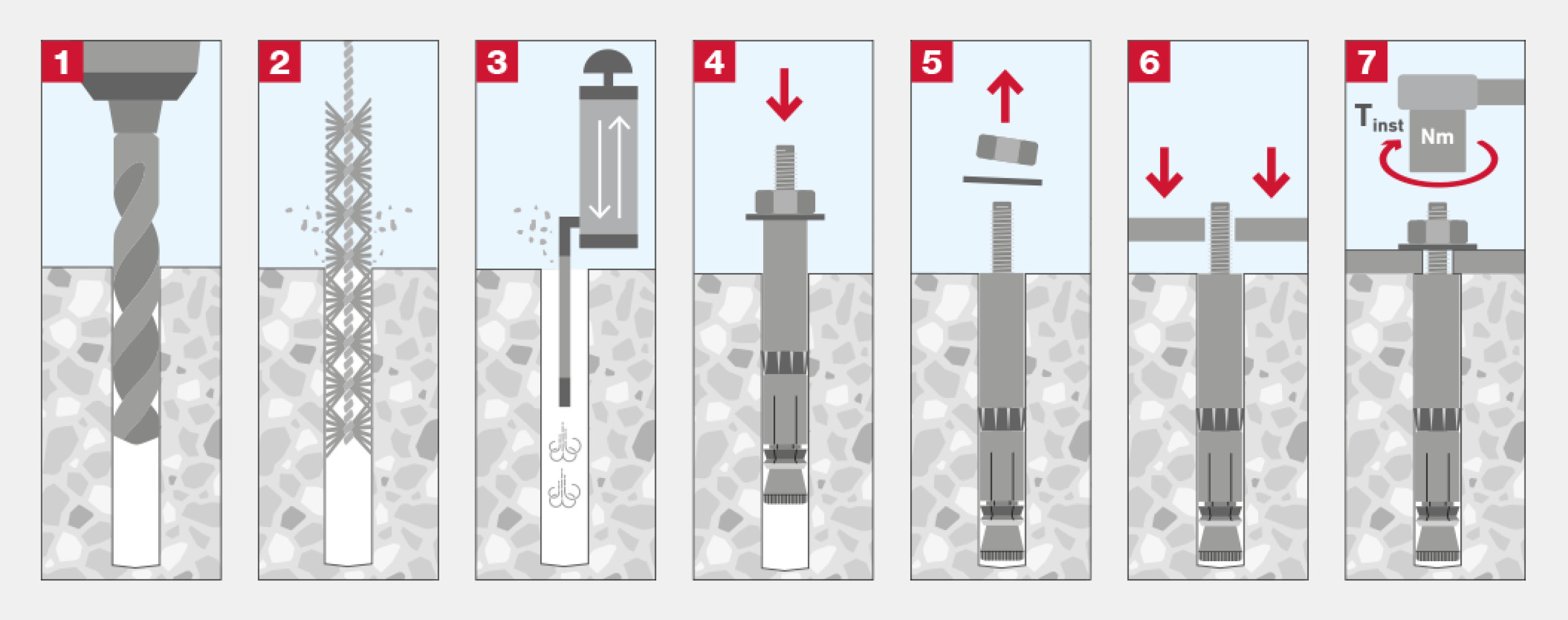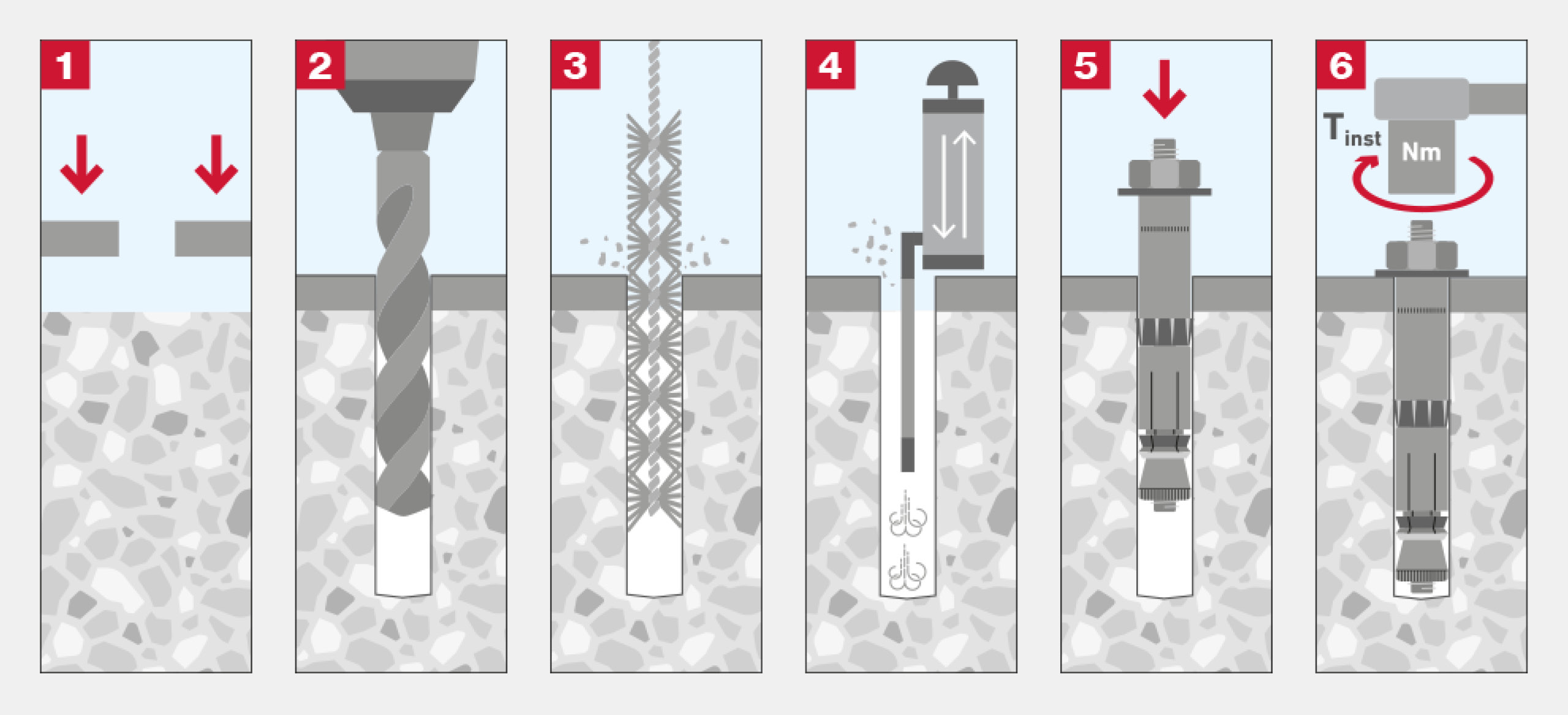Types of assembly
Heavy-duty anchor Guidebook – Part 6
In the sixth article of our guide on heavy-duty anchoring, we show which types of installation play a role in heavy-duty anchoring and how they work. Because in addition to the selection of the suitable fastener, installation that is safe under construction law also requires professional installation.
A distinction is usually made between pre-positioned installation and push through installation. Let´s take a closer look at the two types of installation below:
First a hole is drilled according to the product data and cleaned using a cleaning brush and blow-out pump. (1-3) In the next step, the anchor is inserted into the fastening base. If multi-part anchors are inserted, please note that the steel sleeve is completely sunk in the concrete. This is the only way to use the full cross-bearing capacity. Heavy-duty anchors such as our BA Plus through bolts have a depth-of-set marking, which also facilitates pre-positioned installation: the anchor is hammered in up to the coloured marking and a correct setting depth is guaranteed without measuring effort. (4) Then the washer and nut of the anchor must be temporarily removed. In the case of multi-part metal anchors, pre-stressing is basically released this way. Our LIEBIG® SUPERPLUS BLS-P pre-installation anchor is therefore equipped with an additional safeguard. It prevents single components of the anchor from falling off. (5) Then the add-on part to be attached is mounted. (6) Finally, the washer and nut are replaced and tightened to the specified torque. (7)
A distinction is usually made between pre-positioned installation and push through installation. Let´s take a closer look at the two types of installation below:
Pre-positioned installation
The process of pre-positioned installation consists of several steps:First a hole is drilled according to the product data and cleaned using a cleaning brush and blow-out pump. (1-3) In the next step, the anchor is inserted into the fastening base. If multi-part anchors are inserted, please note that the steel sleeve is completely sunk in the concrete. This is the only way to use the full cross-bearing capacity. Heavy-duty anchors such as our BA Plus through bolts have a depth-of-set marking, which also facilitates pre-positioned installation: the anchor is hammered in up to the coloured marking and a correct setting depth is guaranteed without measuring effort. (4) Then the washer and nut of the anchor must be temporarily removed. In the case of multi-part metal anchors, pre-stressing is basically released this way. Our LIEBIG® SUPERPLUS BLS-P pre-installation anchor is therefore equipped with an additional safeguard. It prevents single components of the anchor from falling off. (5) Then the add-on part to be attached is mounted. (6) Finally, the washer and nut are replaced and tightened to the specified torque. (7)
For pre-positioned installation, the positions of the boreholes must be very precise, since the through holes are specified in the add-on part. Although this takes more time, cost-effective series assembly is possible because all boreholes can be made without interruption. In addition, the contractor has space to measure the borehole and set the anchor, since the add-on part only follows after the preparatory work has been completed. This means that very sensitive add-on parts can be stored in a protected location until they are installed.
First, the borehole must be drilled. In the case of push through installation, the add-on part is an excellent plate drill jig. It is positioned first to create the drill holes accurately. (1) Now a hole is drilled according to the product data and cleaned using a cleaning brush and blow-out pump. (2-4) The anchor is then installed in the surface through the add-on part using a hammer. This is why we call this push through installation. (5) Finally, the nut must be tightened to the specified assembly torque. (6)
In-place installation
This assembly process also consists of several steps, some of which are similar to pre-positioned installation:First, the borehole must be drilled. In the case of push through installation, the add-on part is an excellent plate drill jig. It is positioned first to create the drill holes accurately. (1) Now a hole is drilled according to the product data and cleaned using a cleaning brush and blow-out pump. (2-4) The anchor is then installed in the surface through the add-on part using a hammer. This is why we call this push through installation. (5) Finally, the nut must be tightened to the specified assembly torque. (6)
To cover a wide range of applications, there are anchors with different head styles. The setting depth marking on the anchors from EJOT considerably reduces the measuring effort for drilling and driving in. It is therefore important to ensure that it remains visible despite the add-on part. Otherwise, the correct setting depth must be marked on the anchor by the technician. But this takes time.
In the case of multi-part anchors such as our LIEBIG® SUPERPLUS BLS, both the threaded rod and the steel sleeve run through the add-on part, whereby very high lateral load-carrying capacities are achieved.
In the case of multi-part anchors such as our LIEBIG® SUPERPLUS BLS, both the threaded rod and the steel sleeve run through the add-on part, whereby very high lateral load-carrying capacities are achieved.


